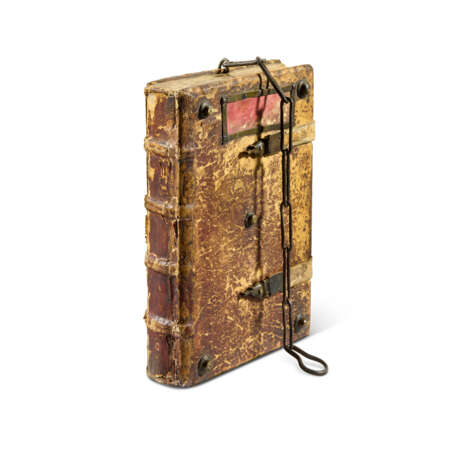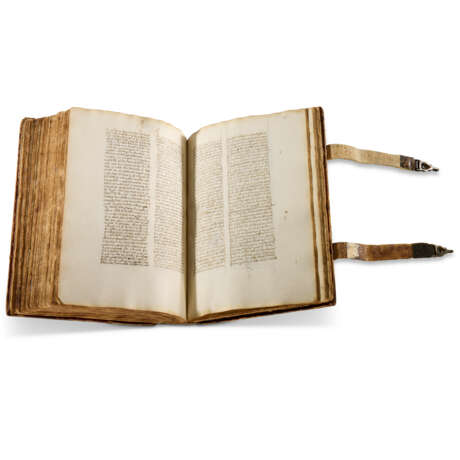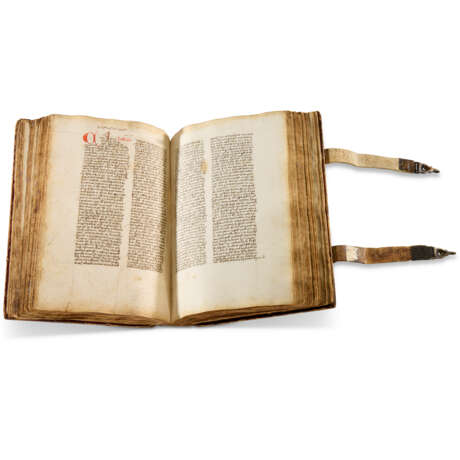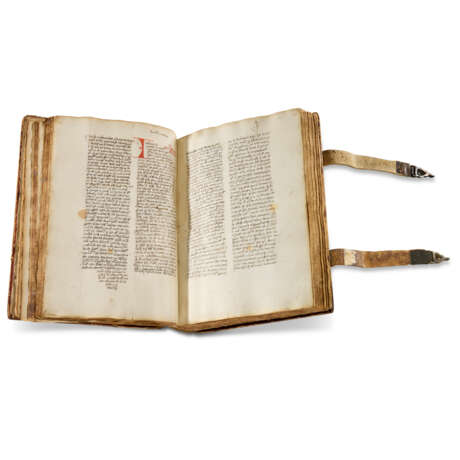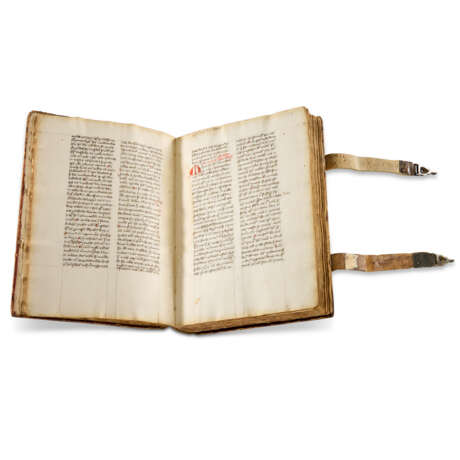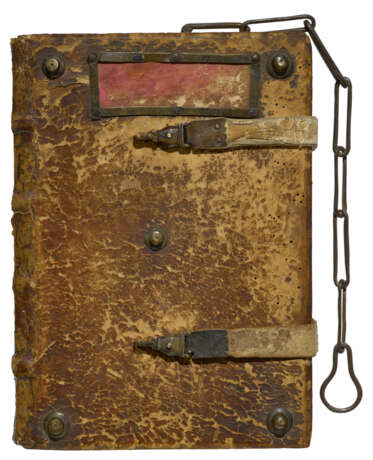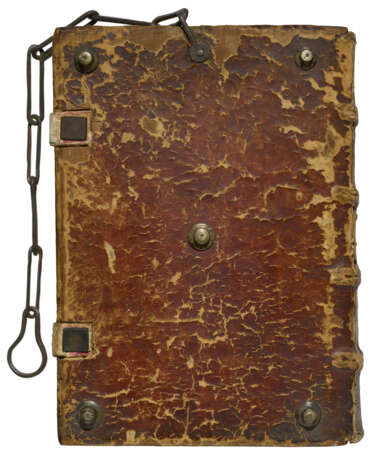ID 1214877
Los 31 | Sintram's Book of Sermons
Schätzwert
£ 30 000 – 50 000
St Augustine (354-430); and Anonymous sermons, in Latin, manuscript on paper [Germany (probably Würzburg)], 1402–1403
A chained binding with the very rare remains of a fenestrum; written and owned by John Sintram, the famous preacher of Würzburg, Regensburg, Strasbourg, Oxford, and elsewhere.
295 × 210 mm. i + 215 leaves, collation uncertain, but apparently mainly in gatherings of 12 leaves, some catchwords, vellum strengtheners in the middle and at the outside of gatherings, frame-ruled in ink for two columns, c. 200 × 130mm, apparently written by several scribes in cursive scripts, typically with c. 34–47 lines per column, some initials in red, spaces left blank for others (a few significant water-stains, sometimes affecting the text, but not its legibility).
Binding:
Medieval chained binding, sewn on four broad bands laced into thick wood boards covered with undecorated skin, formerly stained red as evident by the part that was for centuries hidden behind the title-piece, of which the surrounding metal strips held in place by six nails still survive, each cover with five bosses in a quincunx pattern, the front cover with two pins for strap-and-pin fastenings, the clasps with hinge metal fittings, a chain with eight links attached to the upper edge of the back board, the last link pear-shaped to allow it to be threaded onto a horizontal metal bar at a reading-desk (darkened and with a rough surface, but rugged, sound, and apparently unrestored despite some cracking at the joints, preserving all its fittings except the piece of parchment or paper on which the title was originally written and the piece of translucent horn which protected it).
Provenance:
(1) Mainly written in 1403–04: above the first main Advent sermon, next to the heading, is ‘a(n)no d(omini). m. cccc iiij’ (f.20), and above the second series of Advent sermons is ‘Incepi [...] xl [i.e. quadragesima] scribere a(nno) d(omini) .m.cccciij’ (f.108). Perhaps partly written, and probably owned, by John Sintram (c.1380–1450) (on whom see D.K. Coveney, ‘Johannes Sintram de Herbipoli’, Speculum, 16 (1941), pp. 336–39, and N.F. Palmer, ‘Sintram, Johannes’, Verfasserlexikon 8 (1992), cols. 1284–87); he has been described as ‘not only a great copyist but also a collector of books, writer of sermon-books, translator of Latin into German and German into Latin, and composer of hymns’, and an ‘indefatigable copyist’, who may possibly have written the 61 volumes that he gave in 1444 to the Franciscan house at Würzburg; if he wrote part of the present volume, it could be his earliest recorded work, as the hitherto earliest known volume is dated 1405, written while he was a student at Ulm (London, University College, MS Lat. 4).
(2) From the Franciscan house at Würzburg, as recognised by the late Prof. Nigel Palmer: inscribed ‘Hospitalis est’ (front pastedown, upper left corner). The image chosen to illustrate the term ‘Chained book’ in M. Brown, Understanding Illuminated Manuscripts: A Guide to Technical Terms (British Library, 1994), is a John Sintram volume from Würzburg (BL, Add. MS 44055).
(3) Unidentified 19th-century German(?) owner, with their semi-legible signatures, perhaps ‘Otto Nepner’ (front pastedown) and ‘O Nepner’ (f.192v).
(4) Sam Fogg, London: acquired in 1994 by:
(5) The Schøyen Collection, MS 1833.
Content:
The volume is a composite of several parts:
I. Three works by St Augustine, De bono pacientie, f.2, Ad italicum, and De mendacio (‘Ex libro beati Augustini de mendacio’, f.8); these occupy the first gathering.
II. Advent Sermons, f.18: ‘[E]cce rex tuus venit […] [Matt. 21:5] In verbis premissis tria nobis dantur hodie […]’; these are on an inserted bifolium.
III. Anonymous temporale sermons, from Advent, f.20: the first has a marginal heading ‘Incipiunt sermones de adventu primus dominica scilicet Andrea apostolo’, rubric ‘Incipiunt sermones de adventu domini’, and begins ‘Ihesus Christus alpha et o […] Erat enim vir iste mitissimus super omnes homines […]’.
III. Anonymous temporale sermons, f.107, the first beginning ‘Thesaurizate vobis thesauros in celo […] [Matt. 6:20] Hodie in Christo Ihesu dilectissimi ut scitis […]’, including one to St Cunigunde, f.113.
IV. Sermons on the Passion of Christ, Easter, etc., f.193.
Some pages have extensive marginal notes.
As Palmer writes of Sintram: ‘His importance for the history of literature and the order lies in the fact that in the course of his studies and during his work as a lecturer and preacher he created a large collection of sacred sermon materials, which he used in no small part himself and whose glosses, marginalia and additions provide an insight into the working methods of a committed Minorite preacher’.
His manuscripts have been the subject of several recent studies, including two by K.A. Rivers: ‘Composition and Career: The Composite Manuscripts of Johannes Sintram, O.F.M.’, Collecting, Organizing and Transmitting Knowledge: Miscellanies in Late Medieval Europe, ed. by S. Corbellini et al. (2018), pp.145–60; ‘The Franciscan Johannes Sintram (d.1450) as a Scribe – a Comparative Case Study’, Passionate Copying in Late Medieval Bohemia: The Case of Crux de Telcz (1434–1504), ed. by L. Doležalová (2021), pp.165–80, and Appendix III, pp.277-82, citing the present manuscript.
We are grateful to Prof. Rivers for confirming that parts of the present volume appear to have been written by Sintram himself.
Literature
Rivers, K.A., ‘Johannes Sintram’s Manuscripts and Colophons’, Appendix III in Passionate Copying in Late Medieval Bohemia: The Case of Crux de Telcz (1434–1504), ed. L. Doležalová, L., 2021, pp.277-82.
| Herkunftsort: | Westeuropa, Deutschland, Europa |
|---|---|
| Kategorie des Auktionshauses: | Handschriften des Mittelalters und der Renaissance, Bücher und Handschriften |
| Herkunftsort: | Westeuropa, Deutschland, Europa |
|---|---|
| Kategorie des Auktionshauses: | Handschriften des Mittelalters und der Renaissance, Bücher und Handschriften |
| Adresse der Versteigerung |
CHRISTIE'S 8 King Street, St. James's SW1Y 6QT London Vereinigtes Königreich | |
|---|---|---|
| Vorschau |
| |
| Telefon | +44 (0)20 7839 9060 | |
| Aufgeld | see on Website | |
| Nutzungsbedingungen | Nutzungsbedingungen |
